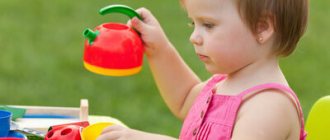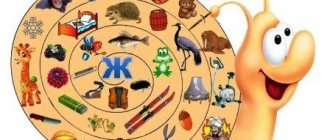What kind of speech is there, you will say, if from him you can only hear a loud “ooh!”, and in moments of calm and blissful mood - “aha” and “aha”, not counting other indistinct and unintelligible sounds. Many parents believe that before their child utters his first words (and this usually happens at the age of about a year), it is useless to talk to him, since he, they say, still does not understand anything and cannot yet learn anything.
However, “unintelligible sounds” are already the formation of speech, and it begins long before the appearance of the first words. And already at this very first stage, the main function of speech is clearly visible - communication. Yes, yes, your baby can and wants to communicate with you!
In order to imagine how to communicate with a baby, let's look at the main stages of speech formation.
The first stage is screaming
When a baby is born, coming from one environment to another, he needs to somehow declare himself, his presence in this world. While the child was in the mother's belly, all his needs were satisfied instantly. Now he sometimes feels some kind of discomfort - and screams (still at the level of an unconditioned reflex). When the baby's needs are met, the child develops a certain behavioral stereotype, and the cry becomes a signal of discomfort (wet, wants to eat or sleep, sad, lonely). The child has only one remedy - screaming. Gradually, with the help of a cry, the baby learns not only to attract attention to himself, but also to communicate. Remember, when your baby calls you, he first screams and then waits for an answer: will mommy come or not? Then he screams louder and waits again. In this way, the child gives his “interlocutor” the opportunity to engage in his first dialogue.
Photo: nastyaofly / freepik.com
Around the third month (and for many babies much earlier), the intonation of screams also changes. An attentive mother can identify many different cries of her child - it could be grumbling, whining, dissatisfaction, a sharp squeal of pain, angry “exclamations”.
“Even if I’m in another room, I can almost certainly tell from the screams what’s happening to my twins. When they quarrel and cannot share toys, the cry is the same; when they are bored, the cry is completely different. And, of course, I always distinguish shrill and sharp “dangerous screams” (when you urgently need to run to help) from “non-dangerous” ones, when children simply express their dissatisfaction.”
The cry is present in the child for quite a long time, developing in parallel with speech. And even when real, “adult” words appear, screaming continues to play a very important role in communication.
Second stage - humming
Buzzing usually occurs at the age of one to two months and accompanies the child in the first six months of life. Usually these are different variations of sounds: a-a-gu, gee-s, ge-e, a-gy, etc. It is curious that babies of different nations walk in the same way. Gradually, the baby’s repertoire is enriched with new sounds, and new intonations appear. In humming, as in shouting, the moment of interaction is also important. Of course, the baby can go for a walk even when left alone in the room. But with your appearance, the partying becomes more active. If you look closely at the child, you will see that he does not just make sounds. At this time, the baby looks into your eyes, waits for your answer, he is already trying to build a full-fledged speech dialogue. And this dialogue must be supported! After all, while walking, the child learns to coordinate both his voice and his gaze, which will subsequently become the basis of any social contact.
The baby seeks your attention and communication using the method of carrot and stick, as ancient as the world, only instead of a stick he uses crying, and instead of a carrot - his charming and joyful smile.
Photo: mimagephotography / freepik.com
Answer your child in his language, support and encourage his first “performances” in every possible way. He will be very pleased with your attention - look how he reaches out to you, tries to purse his lips in order to adequately answer such an important interlocutor! Gradually, the child begins to pronounce long chains of sounds, as if imitating himself. Moreover, he is trying to imitate you too!
A baby at this age is trying to feel sounds and words for the first time. For now, what is important for him is not so much the meaning of words, but rather the different intonations, the rhythm of speech, and the articulation of various sounds.
“My daughter, at the age of four months, began to feel my lips with her hands whenever I said something to her. It seems that she wants to check how different sounds are made, and is trying to catch the words flying out, contrary to the well-known proverb about the word and the sparrow. As soon as there is a pause in my speeches, the baby immediately begins to actively answer me.”
When do the first words and phrases appear?
It is impossible to name the exact date at which children begin to speak their first words. They can appear at 8–9 months and at 1 year 2 months. And all this is the norm. According to the observations of parents and teachers, girls usually start talking earlier than boys, although there are exceptions. At the turn between the first and second years, the baby’s vocabulary contains from 2 to 20 words. Usually this:
- simplified words (ma-ma, pa-pa, la-la, ki-sa, am-am);
- onomatopoeia (beep, peek-a-boo, peep-peep).
It is at this age that the child speaks to his mother. Why do children pronounce words in their native language? Because the adults around him single out from the baby’s babbling syllables and sound combinations that are inherent specifically in their language system, and repeat only them. Therefore, the period of babbling is important for the development of children's speech.
At one and a half years or a little later, the baby begins to combine words into sentences, as long as they consist of two words. The words in them are not consistent, an example of the following phrase: “Give me a doll” (give me a doll), “Papa is not there” (dad is not at home). But this is the age when attentive mothers notice that their baby begins to speak in sentences.
Third stage - babbling
As the child develops, the humming subsides and is replaced by babbling. This usually occurs at the age of 6-7 months. Your baby begins to pronounce individual syllables “ba”, “ma”, “ta”, etc. - at first once, very rarely and as if by accident. Gradually, syllables are heard in his speech more and more often, they are repeated in the form of chains: ba-ba-ba-ba, ma-ma-ma-ma.
Booming and babbling are very important for the further development of speech. If your baby doesn’t have them, try to activate them.
Photo: dusanpetkovic / freepik.com
Holding the baby in your arms so that he can clearly see the movement of your lips, repeat various syllables, sing rhythmic songs, read simple rhymes, and most importantly, talk to the baby as much as possible. He needs to hear adult speech. However, these should not just be conversations that adults have with each other, but speech addressed specifically to him, to the child.
“My son is now 6 months old. He distinguishes different voices by ear. If I talk to him, hiding behind the diaper, he starts smiling joyfully and looking for where his mother has gone. And one day he heard the voice of someone else’s uncle from the hallway - it was a thick bass voice, completely different from his father’s voice - he heard it and began to cry loudly.”
“My ten-month-old Dashunya loves to “read” books - most of all traditional Russian fairy tales for little ones, “Kolobok”, “Turnip”, “Ryaba Hen”. She also really likes conversations on the topic: who talks how. The variations are endless – from a pussy to a big-ass truck or a steam locomotive.”
Again, even if it seems to you that the child is babbling to himself, nevertheless he is very eager to communicate with you. The first babbling words-syllables do not yet carry any meaningful meaning. But it is thanks to the mother, who hears the words in these syllables, that the babbling is filled with meaning.
“Surprisingly, Fedya began to speak the syllables “ma-ma” from the first days. Of course, at first he cried so much. But gradually, he realized that his “mama” especially touches me, especially since everyone said around him that he was calling his mother.
By six months, this “mama” began to mean not “come to me,” but “give me MOMMY here.” At eight months old, he clearly addressed me, and called me while in the arms of others, and there was no doubt that this was already a real word.”
Generally accepted norms and age characteristics
Parents' expectations are different and often do not coincide with the child's actual capabilities. Therefore, experts have developed standards that outline the abilities of the average child in accordance with age:
| Age, months | Speech capabilities |
| 1 | The method of communication is a cry, with which the child notifies of the need for attention. A month later, the baby begins to pick up extraneous sounds and shows a reaction to speech addressed to him. |
| 2-3 | A “revival complex” is observed. The parents' faces evoke a storm of emotions, which he expresses by twitching his arms or legs, as well as cooing. |
| 3-5 | A child attracts the attention of adults by humming (a combination of sounds in the wrong order), smiling or looking at them. |
| 6 | A period of indistinct babbling begins, which is different from humming. If the child is in a good mood, then for a long time he can repeat the sounds “ma-ma-ma” and others. |
| 7 | A reaction to one’s own name appears, and attempts to control voice intonation begin. |
| 8 | The formation of an active vocabulary begins. The child tries to repeat simple phrases heard from his parents. |
| 9-10 | Masters gestures and can point to things of interest. There are up to 10 monosyllabic onomatopoeias in stock. |
| 11-12 | The time when the words “mom”, “dad” and others appear in the lexicon. The child responds to speech addressed to him and is able to point to parts of the body and or animals. |
| 15 | There are already up to 15 words in the active vocabulary. The passive begins to expand, namely, it becomes possible to understand speech addressed to it. |
| 18 | Conscious pronunciation of at least 20 words. He is not hampered by two-word instructions: take the ball and give it to me. |
Lesson or communication?
Of course, when communicating with a child, we teach him one way or another. But try not to let your desire to teach your baby literally from the cradle overshadow a more important thing - your live emotional communication.
Photo: ShevtsovaYuliya / freepik.com
If you follow the theories of early development, you probably heard the name of the American scientist Glen Doman, who argued that, being in a special learning environment from a very early age, a child can achieve very high intellectual results. At his Institute of Child Development, Doman conducted many experiments, the essence of which boiled down to the following. Beginning at two months of age, when their eyes begin to focus, infants were rapidly shown various cards depicting letters, words, notes, numbers, pictures, hieroglyphs and much, much more. During the demonstration, the teacher or mother named the corresponding object. At first, such “lessons” lasted 5-10 minutes, then their duration gradually increased.
When the kids grew up, this is what became clear. They really remembered information perfectly, spoke foreign languages, read, counted, etc. But at the same time, the kids did not play at all; their emotional sphere was disturbed. Accustomed to only passively absorbing didactic material, they did not strive for active knowledge of the world around them; creativity was inaccessible to them, since they had no real creative experience. And they could not always put into practice that huge store of knowledge that their tenacious childhood memory stored. The saddest thing is that the emotional disturbances in these children were already irreparable. After all, many very important milestones of emotional development are laid precisely in infancy, when the child wants and can communicate, build social models of behavior, and not record countless dry facts in his brain.
In my psychological practice there was a boy, Andryusha, who could not adequately communicate with his peers. He ran in circles, constantly repeating the same phrase. At the same time, he had very big problems with the articulation of sounds: at the age of five he simply could not pronounce about fourteen sounds, so it was difficult to understand him. He preferred to communicate in writing.
It turned out that Andryushin’s mother was at one time very interested in the early intellectual development of her son. As a result, he learned to read before he spoke. At the same time, he did not play, studying numbers, letters, special cards, and only drew geographical maps.
When starting to teach your child letters in infancy using a newfangled developmental method, be careful! Some children who were taught to read, for example, using Zaitsev's cubes before they began to speak, had delayed speech development. Instead of engaging in live communication, they read and wrote using blocks.
When does conscious speech begin to form?
The baby begins to consciously pronounce words when he reaches one year of age. Elementary words (“mom”, “dad”) begin to be used in context (for example, “give me mom”). But this is only the initial stage on the path to becoming conscious speech. Then comes a period of active development of passive and active vocabulary, which will allow the baby to associate objects and clearly express his opinion or desire.
A child learns to formulate simple sentences at the age of one and a half years. He already has enough knowledge to form simple phrases (for example, “the doll fell”). The appearance of the first verbs is observed, which may be incorrectly compared with the genders of nouns and pronouns. It’s quite normal to hear the sentence from your baby’s lips: “Sasha is playing” (instead of: “I’m playing”).
When a child reaches the age of two, he already has 50 words in his active reserve, which he builds into sentences (for example, “I went for a walk” or “I want to play”).
At the same time, the baby perfectly understands the speech of adults, remembers and reproduces short rhymes and nursery rhymes. Further, his vocabulary will rapidly expand, which will allow him to express his thoughts in a more complete form.
See also:
How to teach a child to speak at 2 years old and how many words should he know?











